


 |
October 16 - November 1, 2012: Our Fall Trip to Florida |
 |
September 27, 2012: Prudence and Nancy at the Arboretum |
 |
Return to the Index for 2012 |
Well, as if we haven't seen the Chihuly Exhibit at the Dallas Arboretum three times already (first with Rudolf, then with Guy and lastly with Prudence and Nancy), we are going yet again. But this time it will be different; we are going to see the installations lit up at night. This is a special event at the Gardens, and is extra even for members. But it is supposed to be quite something, so we are going to make the trek this evening.
Getting to the Dallas Arboretum
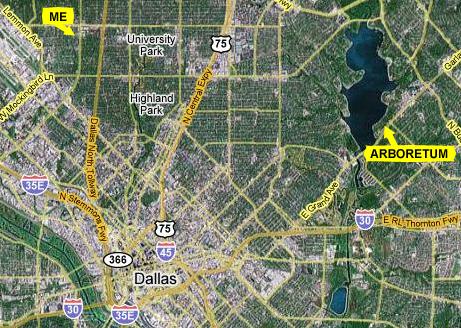 |
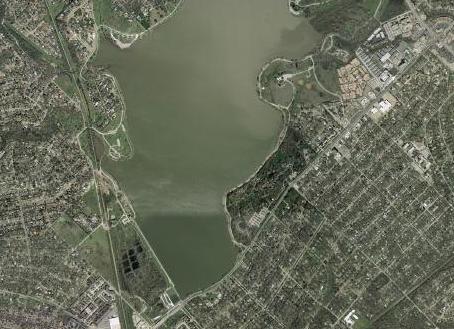 |
The bike path used to cross the top of the dam, but for one reason or another, the bike path was rerouted a year ago, and now it goes through some parkland and playing fields south of the dam, across the spillway, up Garland Road for a ways, and then back north along the lake shore.
You can also see a closer view of the Arboretum in this picture, and can begin to pick out some of the pathways through the gardens.
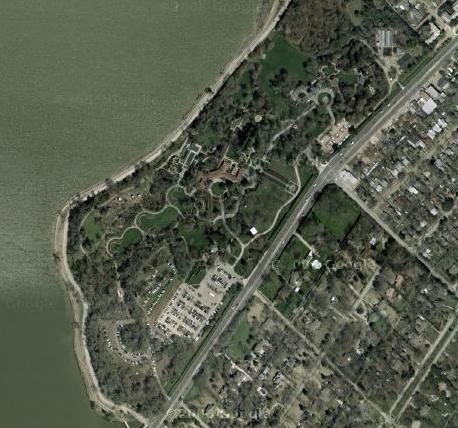 |
You can also see the maze of pathways that criss-cross the gardens.
We usually make a circular transit of the entire Arboretum each time we visit; this enables us to see everything with a minimum of backtracking. This evening, we are adding the hope to see each of the Chihuly installations after dark- when it is lit up. I know that is probably not important for you to know where in the gardens each of the Chihuly installations is located, but I always think it is interesting to let you follow along with us on a map or diagram. Below is a large diagram of the Dallas Arboretum, with our general route marked in yellow and the major gardens noted in red.
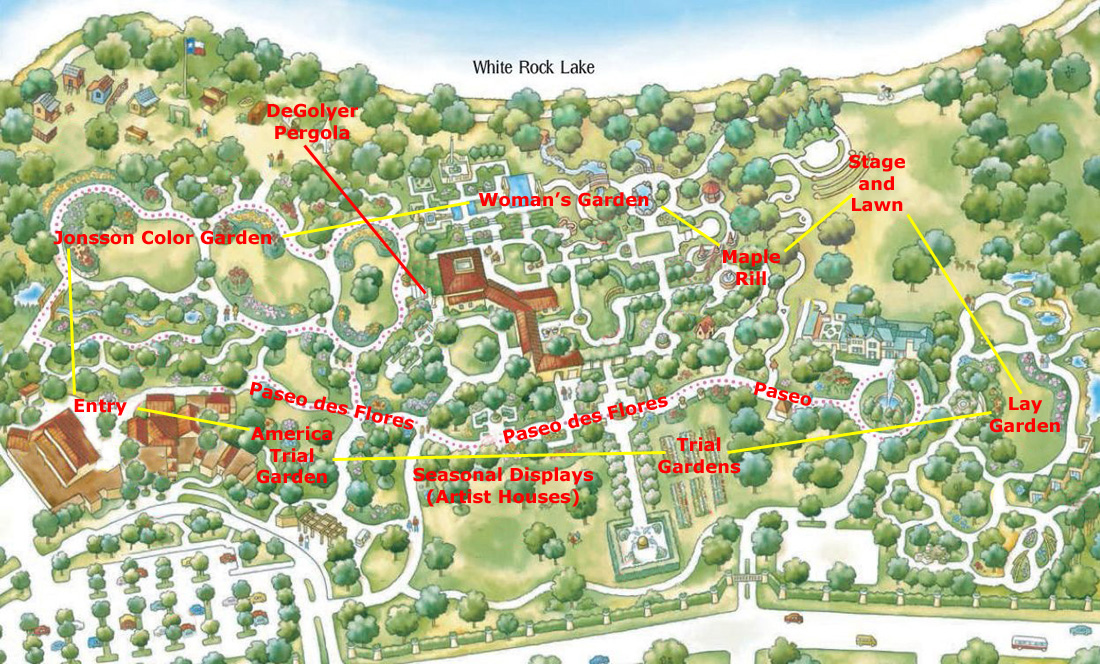
|
Our route this evening will be a bit different. We arrived when it was still quite light, but didn't want to just sit around waiting for darkness, so we started off on pretty much our usual route. By the time we got to the back of the Gardens (in the Lay Ornamental Garden) it had gotten dark enough for the glass installations and their lighting to stand out. We circled back by the installations we'd already passed to see them once again now that their lighting was on.
Rather that have two circuits of the gardens, I am going to combine them into one, and if we happened to take pictures of a certain installation both in the daylight and at night, I'll put both in the same section. This will avoid a great deal of repetition, and might well be interesting when you see the same piece in daylight and at night.
So let's head off from the parking area into the Arboretum to experience "Chihuly at Night".
Cissy Thomsen Welcoming Water Wall
Installation Name: Blue Icicles
|
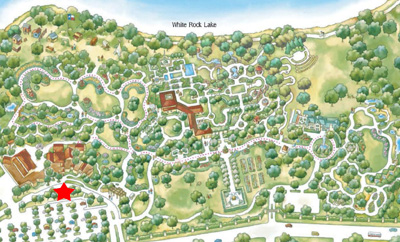
|
In 1996, Chihuly developed an element for his Icicle Creek Chandelier that he hoped could withstand the snowy winters and hot summers of Central Washington state. The resulting icicle form, both beautiful and sturdy, has become a favorite of the artist in a number of outdoor installations since then. One icicle part in your hand is remarkably heavy. Wherever they are placed outdoors, and no matter what the color, the add a startling visual punch. Here at the Arboretum, the clear, turquoise and cobalt icicles reflect the Texas sunlight in dramatic fashion. Before we entered the Arboretum proper, I took one more picture of Fred with the Blue Icicles.
Ginsburg Plaza
|
The entry point here at the Arboretum is the Ginsburg Plaza, which is situated between the restaurant, gift shop and educational center.
With the pumpkins and gourds having arrived for Fall and Pumpkin village, Ginsburg Plaza was lined with them.
|
A Look Around Ginsburg Plaza |
Fred also took some additional pictures of the beautiful pumpkin and gourd decorations all around the plaza, and you can use the clickable thumbnails below to have a look at a few of them:
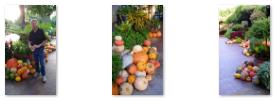 |
Installation Name: Mexican Hat and Horn Tower
|
I want to include one more picture of Fred with the Mexican Hat and Horn Tower.
The Palmer Fern Dell
|
Here, we found the first of many installations of a genre that Chihuly calls, simply, "Garden Glass." These were tall, slender grass-like shapes, sometimes straight and sometimes with curliques at the top. The color seemed to complement the place in the garden where they were located. Usually, they had different names.
Installation Name: Blue Marlins
|
I've put clickable thumbnails below for some additional views of the Blue Marlins; Fred's are close-up and mine show the setting:
  |
Installation Name: Turquoise Reeds
|
Both the different installations were very pretty, and their deep blue color suited the deep shade of the fern dell. You can see me with the Turquoise Reeds here.
The Jonsson Color Garden
|
Here, we found a number of different Chihuly glass installations.
Installation Name: Yellow Icicle Tower
|
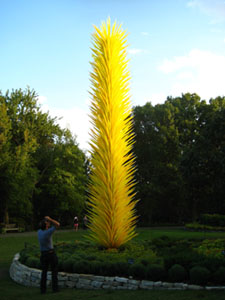 |
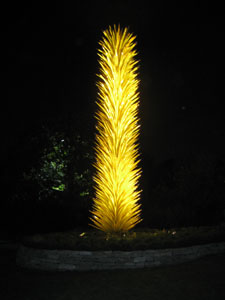 |
This installation is the tallest in the gardens, and you can see it from a long ways away.
|
I also want to include a single picture of Fred and I in front of the Yellow Icicle Tower; you can see that picture here.
Installation Name: Cattails and Silvered Red Bamboo
An example of Chihuly's Garden Glass series, the Cattails and Silvered Red Bamboo are based on plant-like forms, and this was just one instance of this form in the gardens. Below are views of this particular installation in the daytime and at night:
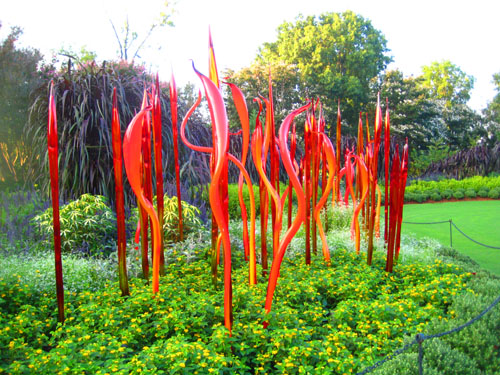 |
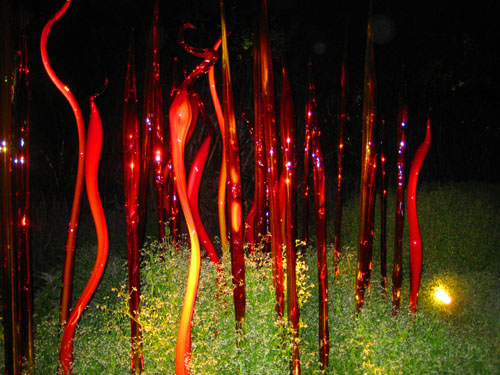 |
This installation was a combination of two forms- the tall, slender, straight cattail form, and the more plant-like bamboo. There are clickable thumbnails below that you can use to see some additional pictures of this installation, both in daylight and at night:
 |
Installation Name: Tiger Lillies
|
Today, we didn't happen to take any pictures of the Tiger Lillies installation in the daytime, but you have probably seen one on a previous page. The picture at left was, of course, taken after sundown.
Fred did get another excellent night view of this installation, and you can see it here. And below are clickable thumbnails for some additional nighttime pictures that I took:
 |
Installation Name: Niijima Floats
These large spheres- up to 40 inches in diameter and 60 pounds- have surfaces richly colored with gold and silver leaf and foil. They are named for Japanese fishing floats Chihuly found as a child on the shores of Puget Sound and the island of Niijima, Japan, which Chihuly visited around 1990. This particular installation was tough to photograph at night, for the glass globes were not lit from inside, but rather from indirect lighting nearby.
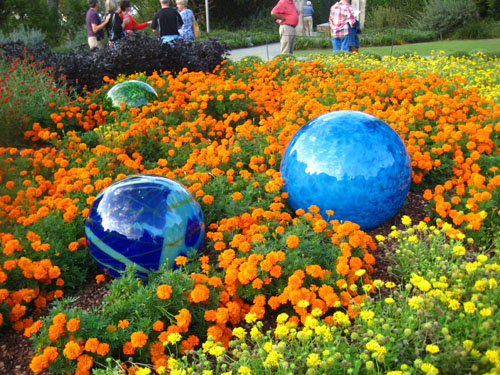 "Niijima Floats" (Day) |
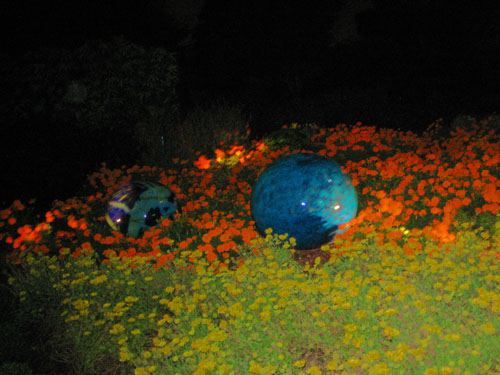 "Niijima Floats" (Night) |
As you can see in two of Fred's daytime pictures of the Niijima Floats (you can see them here and here), Chihuly has colored them to blend in with the color scheme where they have been placed. Here is a picture of Fred with the nighttime Niijima Floats.
A Woman's Garden
|
The main entrance to the garden is through the portal at the northeast end of the Jonsson Color Garden; this brings the visitor to the top of a stairstepped water feature that leads down into the garden. Small channels of water surround the plain grass center of the area. Steps lead up from this garden to the DeGolyer House.
Installation Name: Scarlet Asymmetrical Tower and Yellow Asymmetrical Tower
From the Jonsson Color Garden, we could look northeast towards the entrance to the Woman's Garden, and we could see the two Chihuly asymmetrical towers flanking the entrance. The Asymmetrical Towers were first exhibited outside of the magnificent Palm House at the Royal Botanic Gardens, Kew, near London in 2005. Here in Dallas, the Towers welcome the viewer to come explore A Woman's Garden. Also, with this installation, the artist reminds us that liveliness and natural form comes from asymmetry.
|
You can see their position in a photograph we took a bit later from down inside the Woman's Garden looking back across another Chihuly installation towards that entrance. You can see that photo here.
When we returned after dark, we came up to the towers from the garden itself, and you can see Fred with the pair of them in the background in a picture I took from down in the garden. Then we walked up and out of the garden to see the Towers from the other side. They were indeed pretty spectacular all lit up, as you can see in one of Fred's closeups here. Trying to get them both in one picture was tough, so I composed a panorama of the two of them out of three different pictures; you can see that view below:
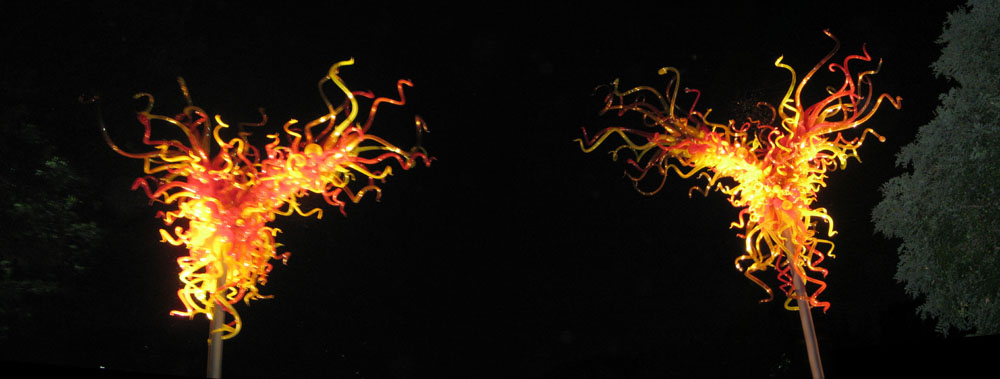 |
Going through the portal, we find ourselves at the upper fountain at the beginning of the stairstepped water feature leading downwards. We came through the Woman's Garden twice this evening- first when it was still light and then second on our way back to the entrance after it had gotten dark. So you'll see both daytime and nighttime pictures.
|
Coming Into the Woman's Garden at Night |
Of course, our purpose in coming to the Arboretum yet again was to experience it at night, so let's return to the top of the water feature and descend down into the garden- but this time at night. That's what I filmed when we returned, and you can watch that movie with the player at left.
Installation Name: Neodymium Reeds
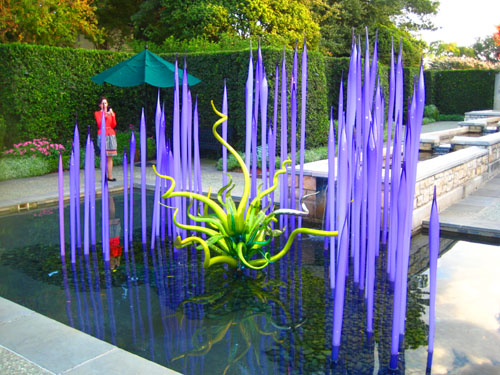 "Neodymium Reeds" (Day) |
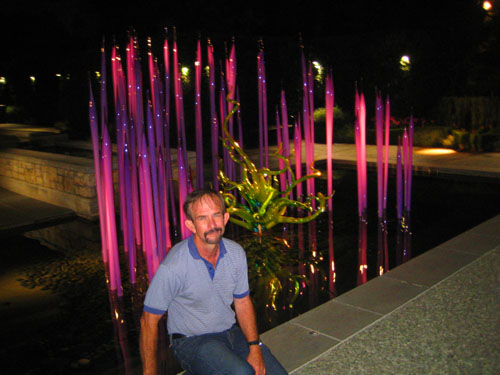 "Neodymium Reeds" (Night) |
Chihuly made the first Reeds in Finland, and these are the same tall, thin sculptures that we would find throughout the garden, in different colors to complement their location. These long, cylindrical pieces look like spears stuck in the ground, and Chihuly is fond of using them in outdoor installations both for their durability and their dramatic effect. These reeds have another, different sculpture at their base (a piece that was unnamed). In addition to the pictures above, Fred took two daytime pictures on our first visit, and two more nighttime pictures on our way back; there are clickable thumbnails for these pictures below:
 |
Installation Name: Aqua Blue and Amber Chandelier
|
When we returned later in the evening to get this picture, we actually re-entered the Woman's Garden by way of the steps down from the DeGolyer Home, You can see the nighttime view from the top of those steps here. The Neodymium Reeds are at the left, the Mirrored Hornets at the right and the Aqua Blue and Amber Chandelier in the sunken Poetry Garden ahead at the end of the walk.
Installation Name: Mirrored Hornets
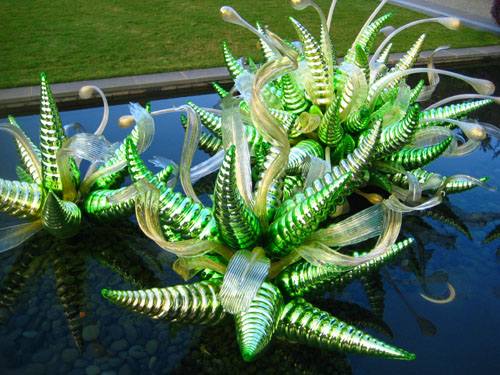 "Mirrored Hornets" (Day) |
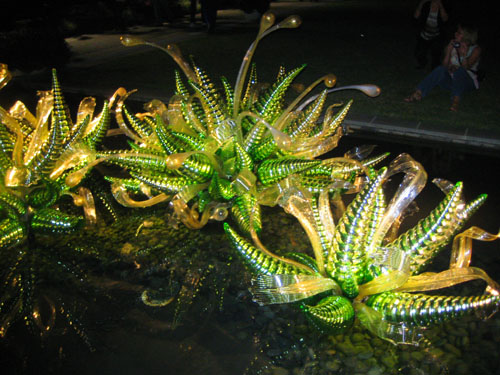 "Mirrored Hornets" (Night) |
In a second rectangular pool east of the Neodymium Reeds is an installation called the Mirrored Hornets. For the Mirrored Hornets, molten glass is blown into a spiral mold to make the Hornet form. The glassblower must literally unscrew the hot glass to remove the form from the mold.
There are three more pictures that I'd like you to see; Fred took the first one before dark and the second two when we returned. You can use the clickable thumbnails below to have a look at them:
 |
Installation Names: Float Boat and Carnival Boat
The next two installations were both in the infinity pool at the east end of the Woman's Garden, and they were both strikingly beautiful- actually more so in the daytime. They were called Float Boat and Carnival Boat, and you can see them both in the daytime here.
|
|
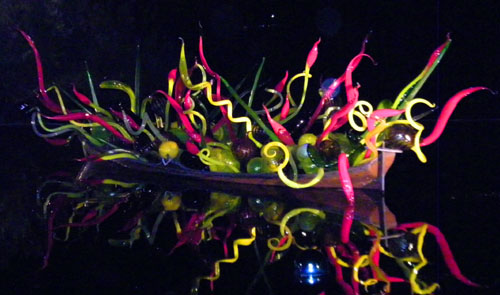 |
The Grotto
|
Installation Name: Persian Pond
The next installation we came to was in the pool that is part of the rock-lined water feature in The Grotto. Chihuly began his Persians series in 1986 as a search for new forms, always for Chihuly being a vehicle for color. Early works in the series were oddly shaped and intensely colored but were soon transformed. As Chihuly continued to expand and modify his Persians, he began to see their potential for large, dramatic installations.
I took a daytime picture on our first visit to the Grotto this evening; on our way back, after dark, only one of the pictures of the Persian Pond at night came out well (the glass flowers were not brightly-lit); those daytime and nighttime pictures are below:
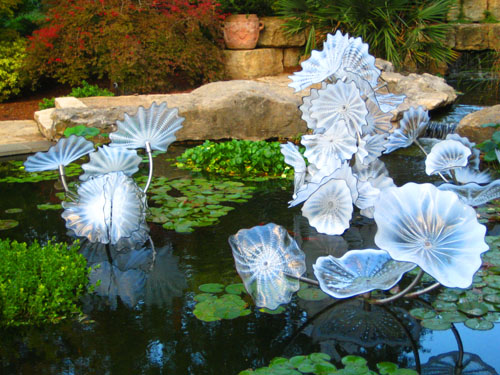 "Persian Pond" (Day) |
 "Persian Pond" (Night) |
The Boswell Garden/Magnolia Allee/McCasland Garden
|
|
The other three were taken in the Boswell Family Garden. This beautiful garden comprises the area north of the McCasland Sunken Garden with the gazebo, octagonal fountain and Magnolia Allee serving as natural boundaries.
As guests enter the garden from the octagonal fountain (near which the installation below is located), an overlook offers a beautiful, unexpected view of the area. A wall provides the backbone of the garden, with a series of circular buttresses covered with red cascade rose trellises. Symmetrical, serpentine plantings mirrored by topiary hollies surround a circular lawn area. Cubed topiary hedges and a red and yellow-leafed barberry hedge in a double-helix configuration align the existing walk to the McCasland Sunken Garden.
Installation Name: Citron Green and Red Tower
|
The two constrasting colors of the Citron Green and Red Tower provide an additional playful pop of color among the vivid Dallas Arboretum blooms.
The Red Maple Rill
|
“The most impressive feature is a fabulous collection of over 80 varieties of 200 Japanese Maples,” commented Dave Forehand, Vice President of Gardens. “Two hundred trees are planted up and down the stream with an understory planting beneath the canopy. An especially large weeping Japanese maple nearly 100 years in age anchors the center of this new garden area.”
The Red Maple Rill increases the Dallas Arboretum’s collection of Acer species and cultivars to over 120 varieties. Not only is this garden a beautiful serene oasis along the Paseo, but is also a horticulturally important garden with an impressive collection of Maple species and cultivars.
Installation Name: Blue Polyvitro Crystals
The installation of the Blue Polyvitro Crystals is one of the few Chihuly sculptures that is not made of glass; in fact, the crystals are made of plastic- although they are inspired by and creating using glass. There were a series of them in the Red Maple Rill stream. Chihuly may have had th eancient stories of the old fortress in Jerusalem in mind when he developed the idea of using large crystals as a form for outdoor sculptures. The first solidly cast plastic crystals were taken from molds of cullet- broken chunks of glass retrieved from the bottom of a furnace. Polyvitro crystals were first used on the Crystal Mountain in the exhibition Chihuly in the Light of Jerusalem (1999).
The term "polyvitro" was coined by Chihuly as a name for any material used in his projects that is actually made of plastic, and created through this glass-molding process. The first crystals he made were blue, and this became their signature color. By 2005 the same large blue crystals were floated in lakes and ponds as part of Chihuly's garden exhibitions. We did see the crystals while it was still light, but when we returned this way they were not lit up.
Installation Name: Sun
Chihuly's Sun is a radiant, 14-foot diameter globe of red, orange and yellow glass branches curling outward from its center. Massed together, the hundreds of twisting glass elements create a powerful effect. Chihuly has said, "No other material gives you color like glass does. No othe rmaterial has the ability to take in light and radiate out color like glass."
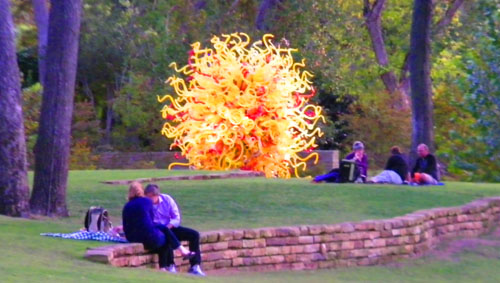 "Sun" (at dusk) |
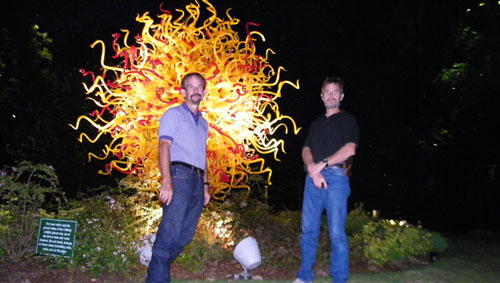 "Sun" (night) |
The installation sits at the edge of the Martin Rutchik Concert Lawn, just on the lawn side of the bridge that crosses the Rill. It does indeed look like a small sun that has descended to touch the earth. I would like to include one more nighttime picture- a closeup of Sun.
|

|
From this point on, all our pictures were either at dusk or at night, and so the daytime/nighttime comparisons will end here. If you want to see more of the Chihuly glass sculptures in the daytime, visit one of the previous pages detailing our visits to the Arboretum with either Rudolf or with Prudence and Nancy.
Lay Ornamental Garden
|
Both the Lay and Trammel Crow families are major participants in Dallas philanthropy. Trammel Crow began as a small property owner and Realtor, and his companies expanded to become a leading name in office rental properties and new construction nationwide. Herman Lay, who died in 1982, began as a Pepsi-Cola bottler in Mexico, and expanded into snack foods in the 1950s. His name is currently one-half of the famous Frito-Lay snack empire which, in a not-so-odd turn, is part of PepsiCo- Herman Lay's first employer. Both men and their families have also been involved with the Morton Myerson Symphony Hall. The Trammel Crow family continues to sponsor concerts, and a branch of the Lay family donated the huge pipe organ that is the pride of the Myerson.
Installation Name: Fiori Sun
"What makes the Fiori Sun work for me," Chihuly said, "is the massing of color. If you take a thousand blown pieces of a color, put them together, and then shoot light through them, now that's going to be something to look at." I do have two contrasting pictures of this installation, one taken just after sunset and one a half-hour later:
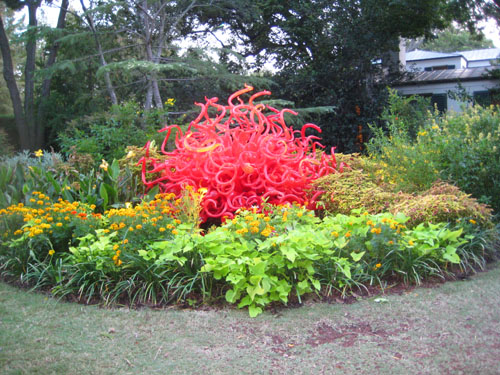 "Fiori Sun" (at dusk) |
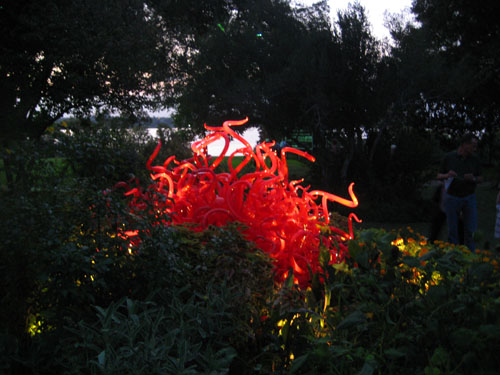 "Fiori Sun" (twilight) |
I'd also like to include a pretty amazing extreme closeup that Fred took of just a small portion of this sculpture. It clearly shows the ribbed, curved, colored glass to be the delicate structure it is. You can have a look at that picture here.
Installation Name: Blue Bulbous Reeds
|
| Installation Names: | Neodymium and Blue Reeds Blue and Pink Marlins |
At the back of the Lay Garden are three waterfalls, and each of them had a different Chihuly installation in them. The first two had the Neodymium and Blue Reeds and the Blue and Pink Marlins, respectively.
|
"Neodymium and Blue Reeds" "Blue and Pink Marlins" |
As far as pictures go, I took one of Fred with the Blue and Pink Marlins, and Fred took a few of both the Reeds and the Marlins; you can use the clickable thumbnails below to see those:
 |
Installation Name: Turquoise and Clear Eelgrass
|
Installation Name: Ferns
The additional installation below was just across the small lawn from the waterfalls:
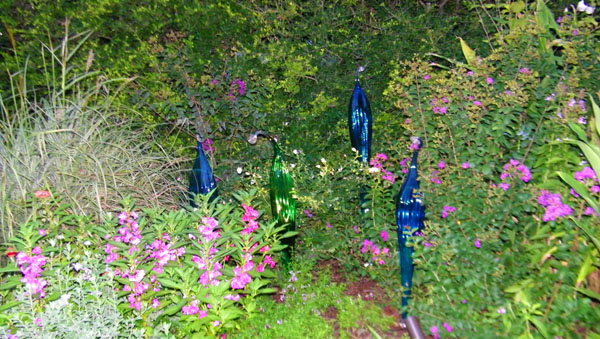 "Ferns" |
Installation Name: White Belugas
|
Paseo de Flores
|
Installation Name: Red Reeds
|
Chihuly made the first Reeds in Finland; the factory's high ceilings made the tall, thin glass sculptures possible (well, that and a mechanical life to raise the glassblower high off the floor). As Chihuly said, "In Finland we started making these long, cylindrical pieces which loojked like spears. This was an exciting new form. It was the first time we ever made anything like that. They can be taken anywhere; they can go outside. They are very strong pieces, and they are very dramatic."
That is certainly true of this installation. The view at right is probably enough, but there are clickable thumbnails below for a couple of slightly different ones:
 |
Installation Name: Ruby Fiddleheads
|
Fred got what I thought was a nice picture of him and me with the Fiddleheads.
Installation Name: Dallas Star
|
The Dallas Star was certainly an energetic piece, and while energy is a characteristic found in all of Chihuly's artwork, this installation exemplified it perhaps better than any other. When asked about the way he works, Chihuly answered, "Quick and immediate and spontaneous, with an element of chance." And asked about where ideas come from he said: "The only explanation I'm ever able to give about where things come from is 'energy.' That has to come out in one way or another. Sometimes it's more destructive, sometimes it's more beautiful, sometimes more creative. Energy can go in so many directions, and you have to harness it. Correction! Youy don't harness it, you use it. You put it to good use."
Back on the Paseo, we headed towards the entrance and the last Chihuly installation.
Installation Name: Green and White Striped Reeds
|
But then we thought that all of Chihuly's pieces were dramatic.
We continued walking down the Paseo de Flores and then doubled back to revisit some of the installations that we'd only seen before sundown; that's when we took the night pictures of them. We left the Arboretum about nine-thirty, having seen just about everything. The glass was pretty spectacular all lit up at night.
You can use the links below to continue to another photo album page.
 |
October 16 - November 1, 2012: Our Fall Trip to Florida |
 |
September 27, 2012: Prudence and Nancy at the Arboretum |
 |
Return to the Index for 2012 |